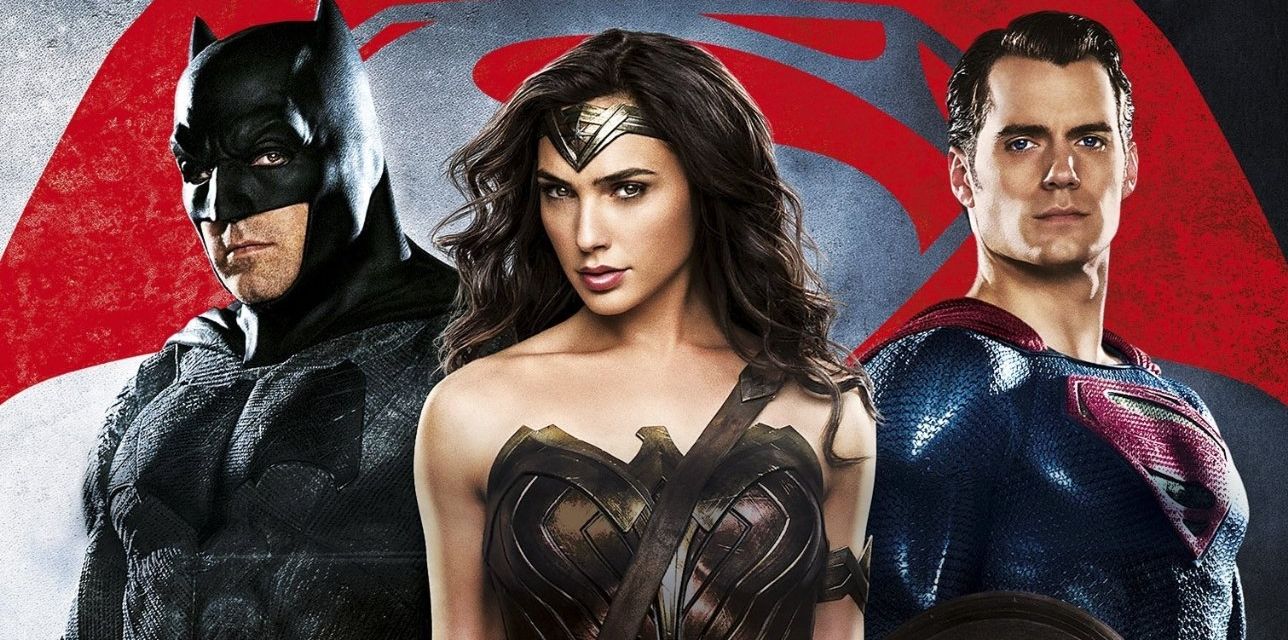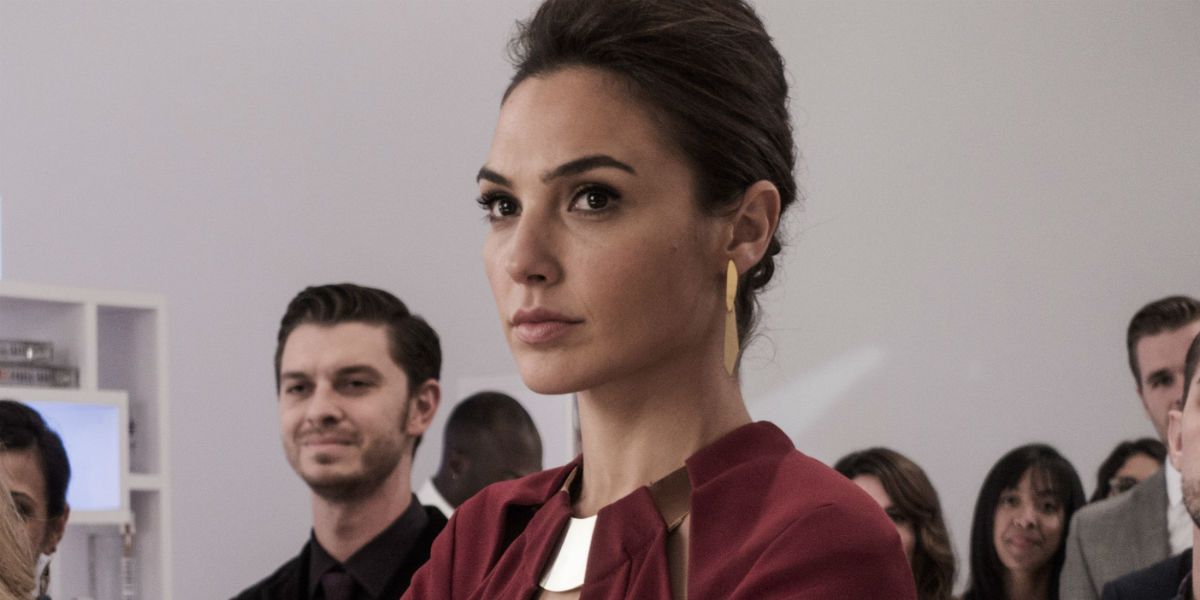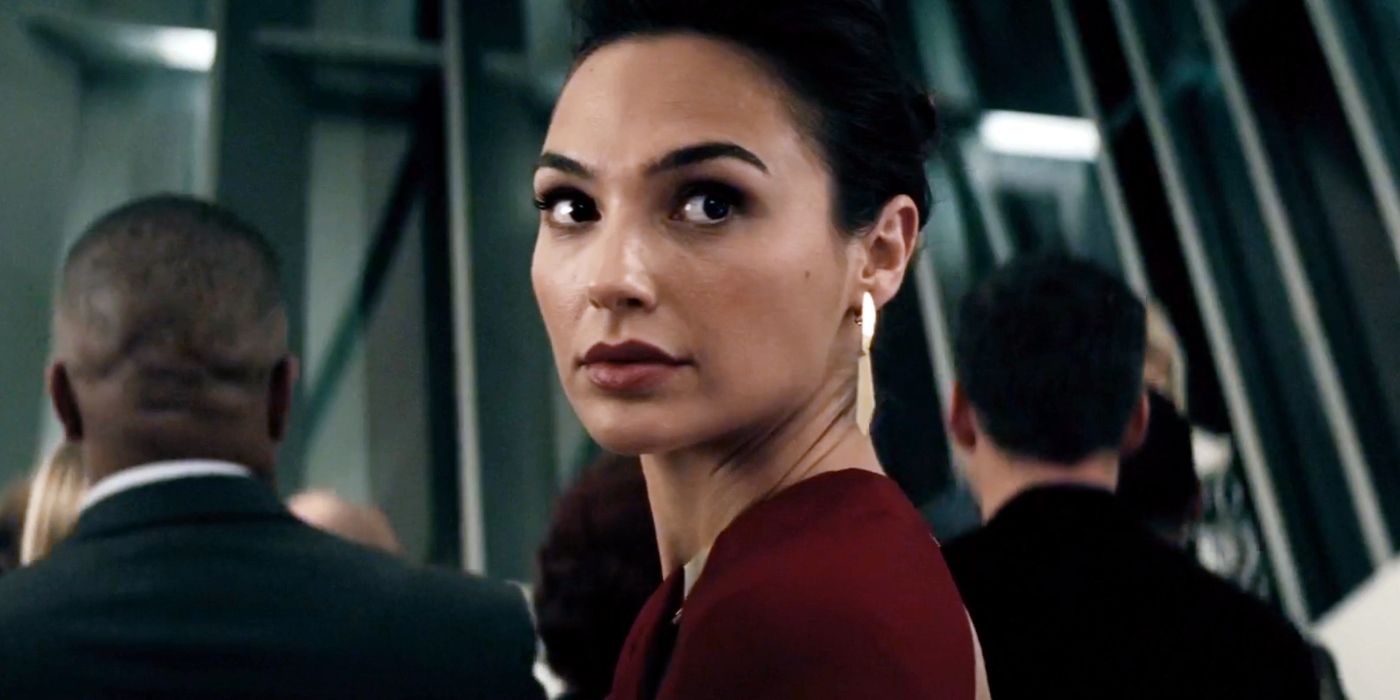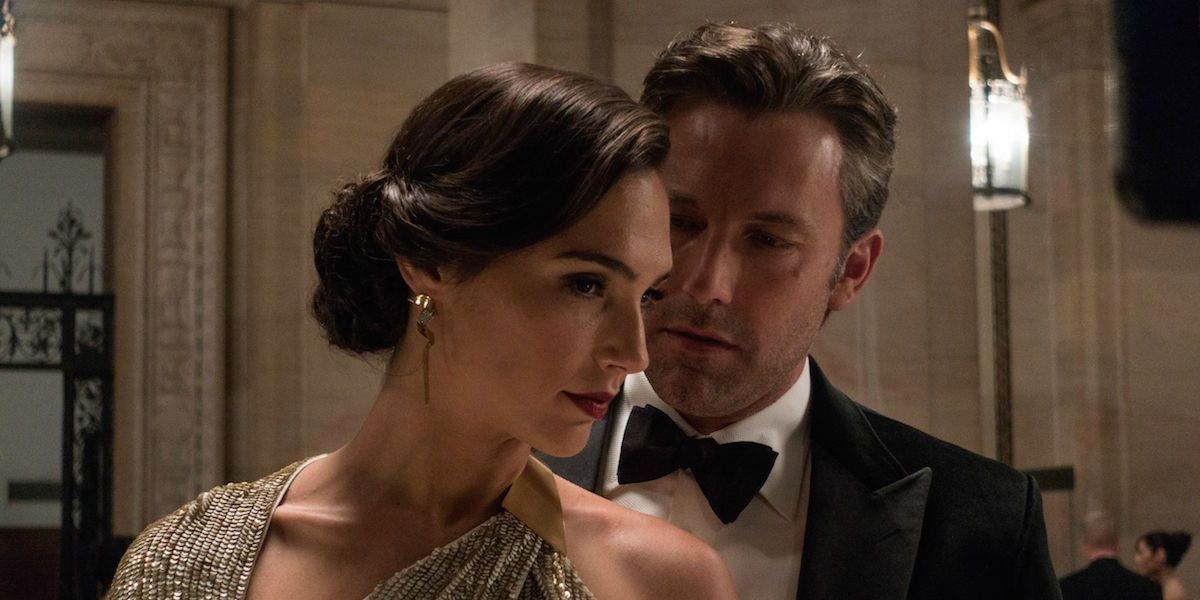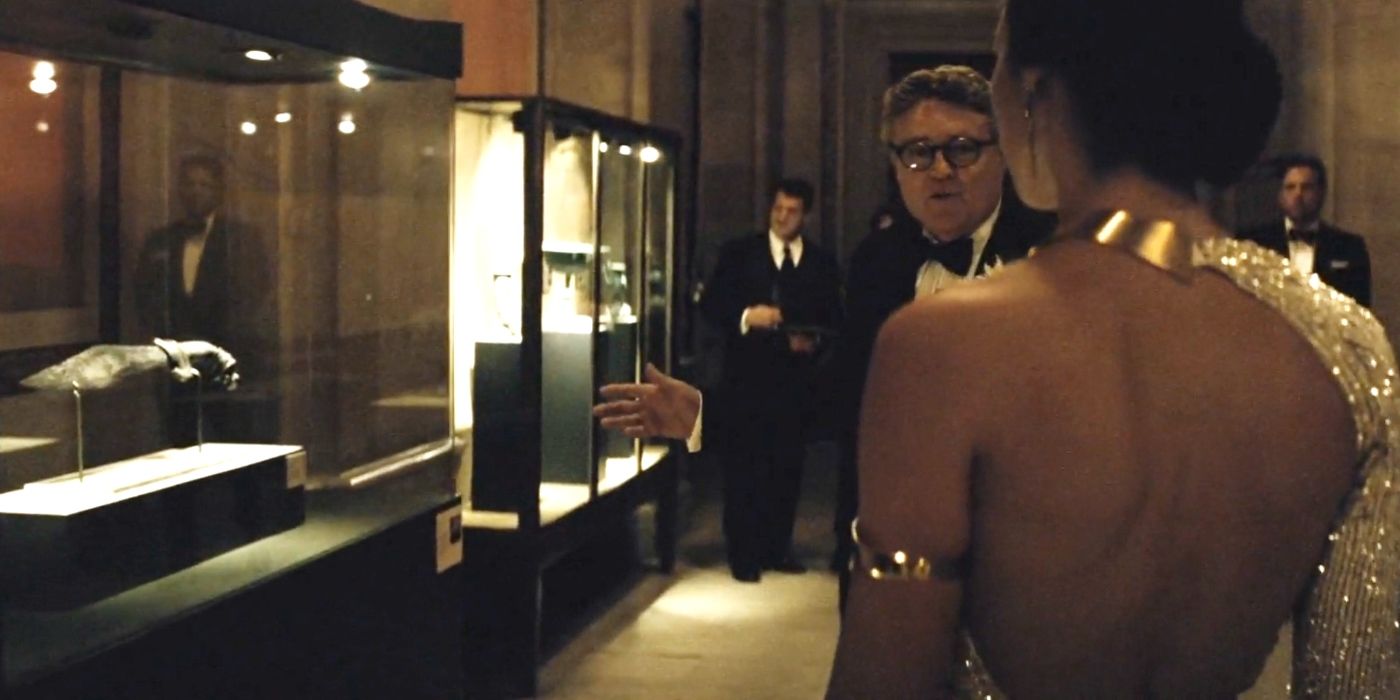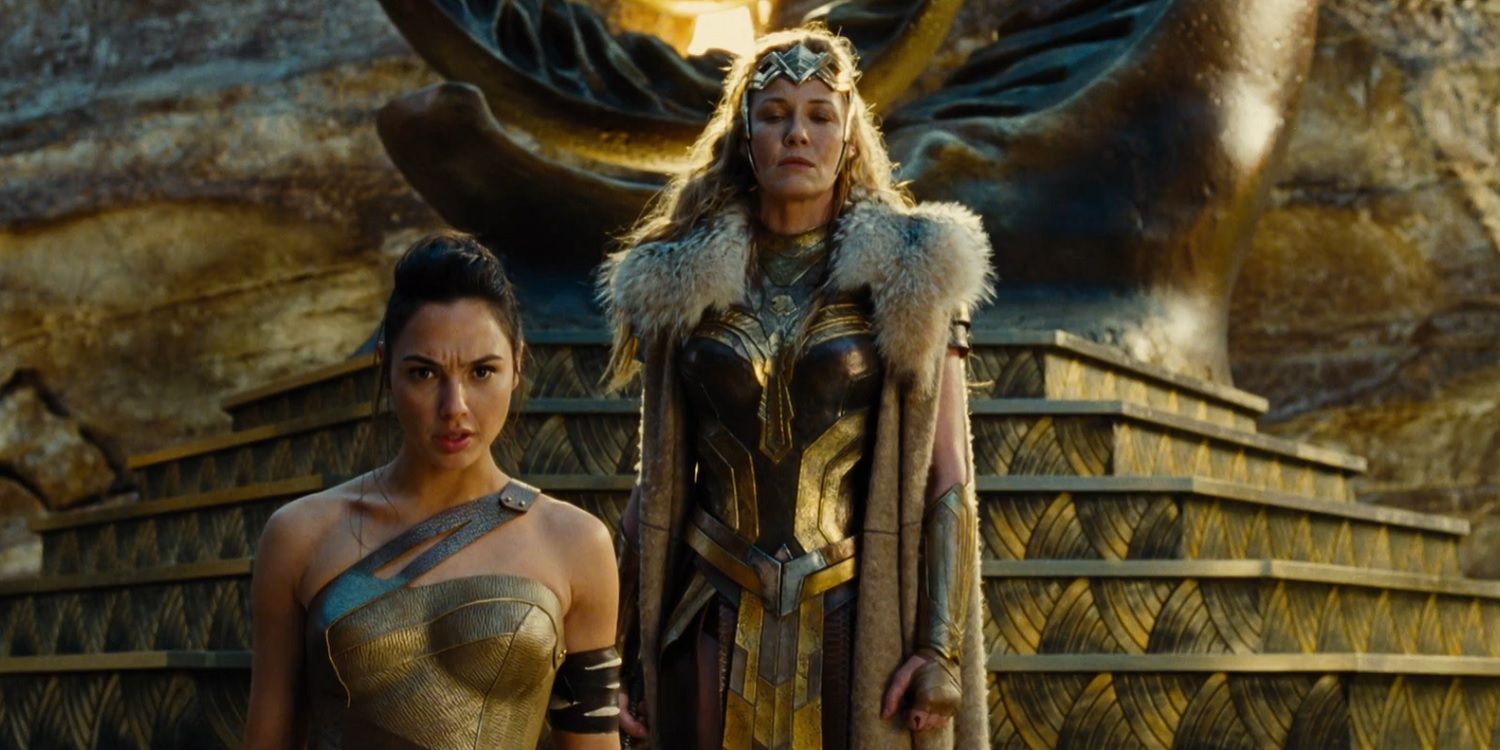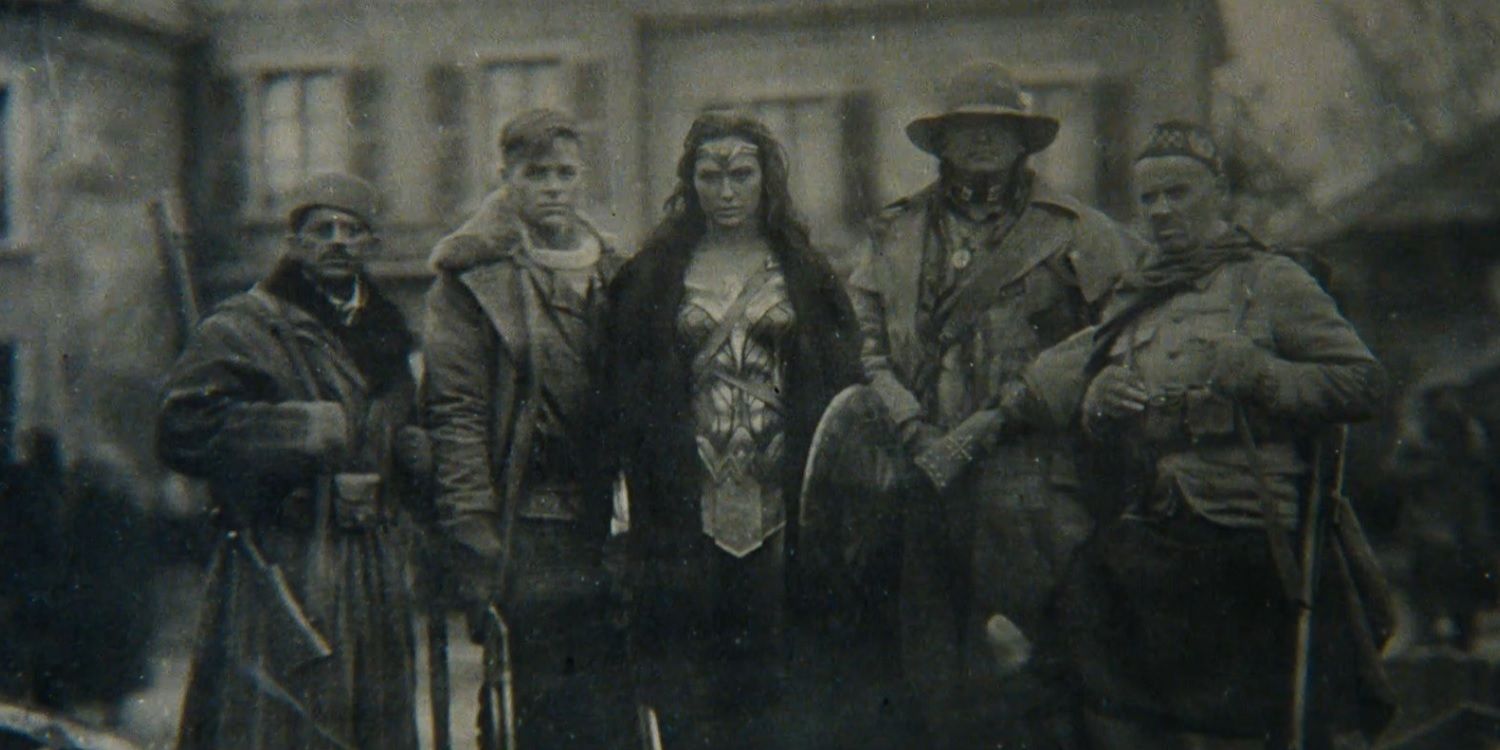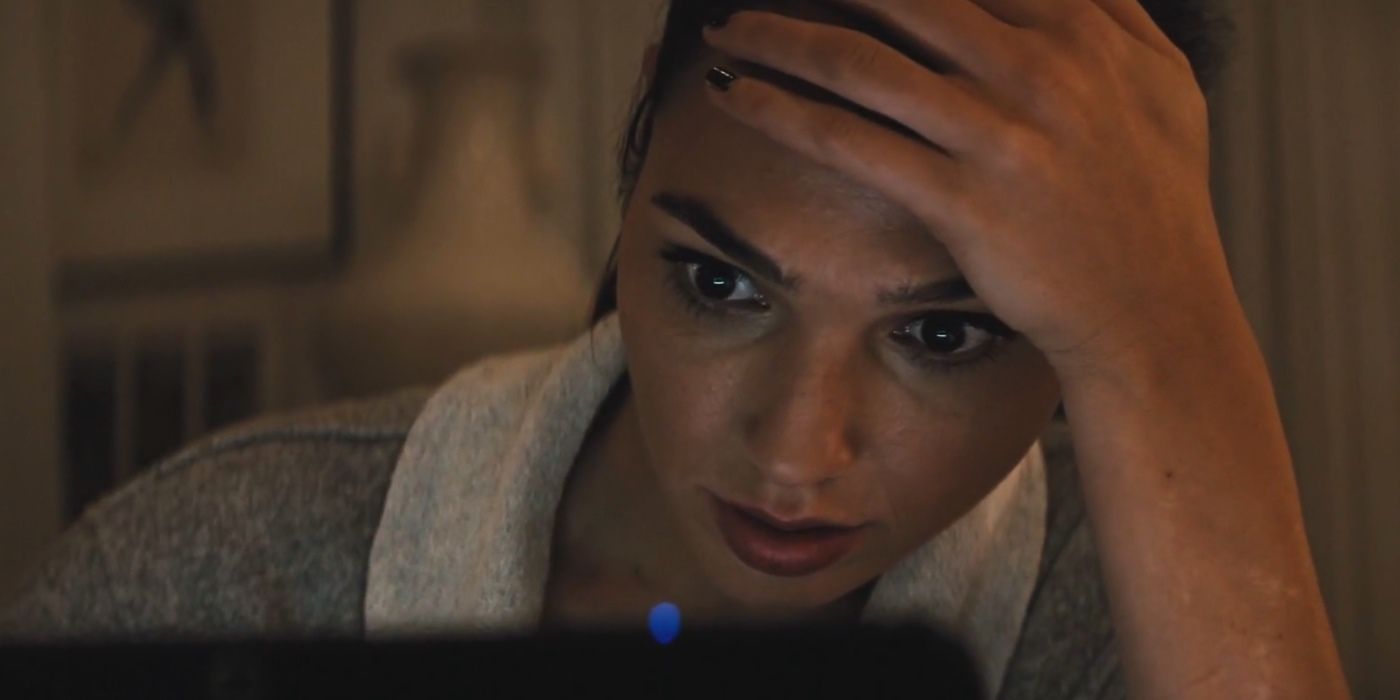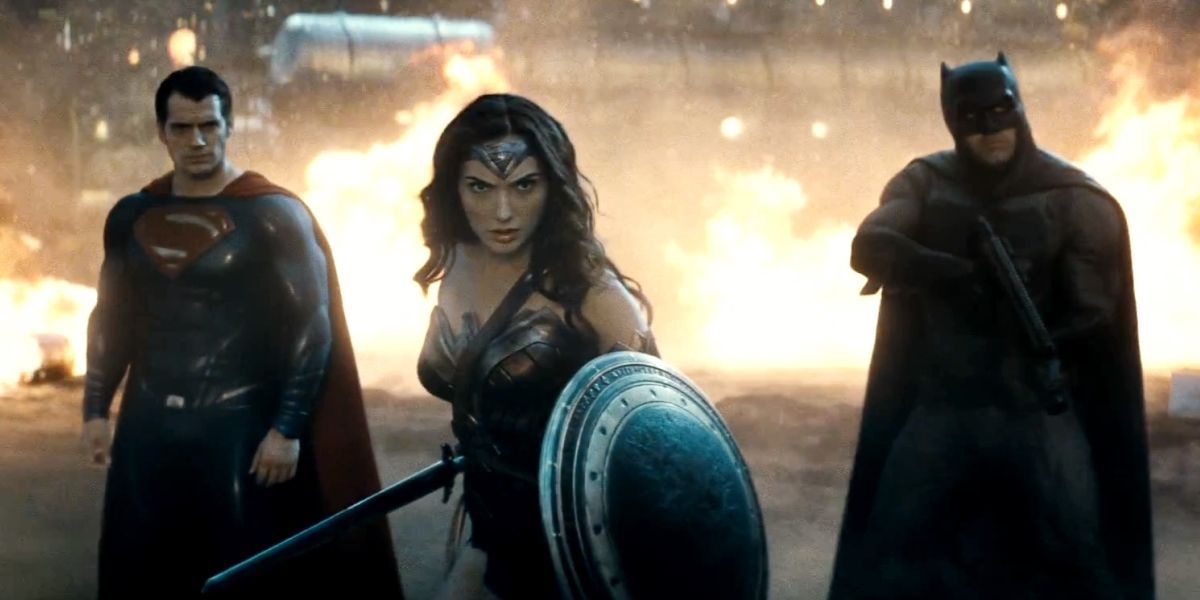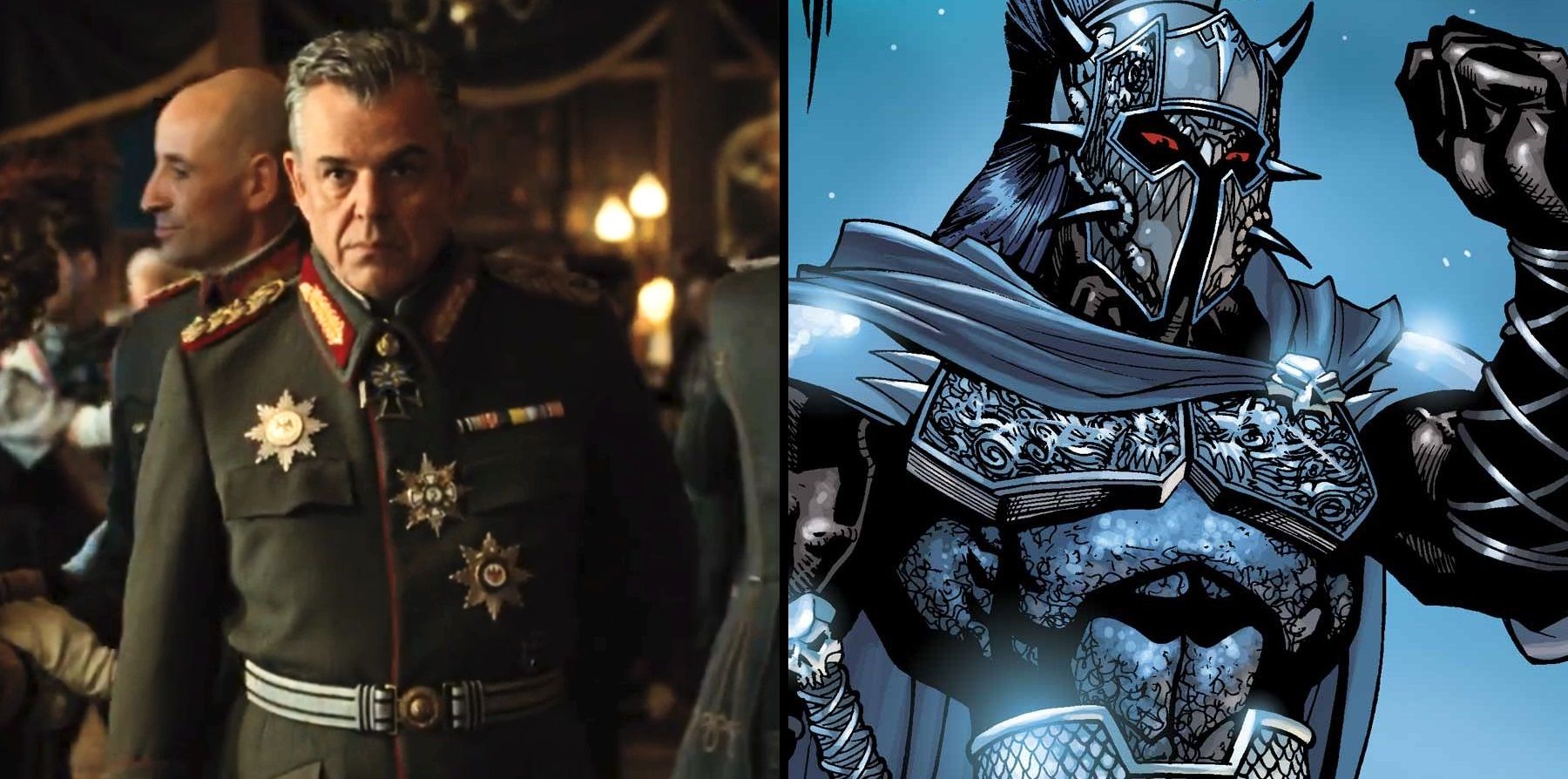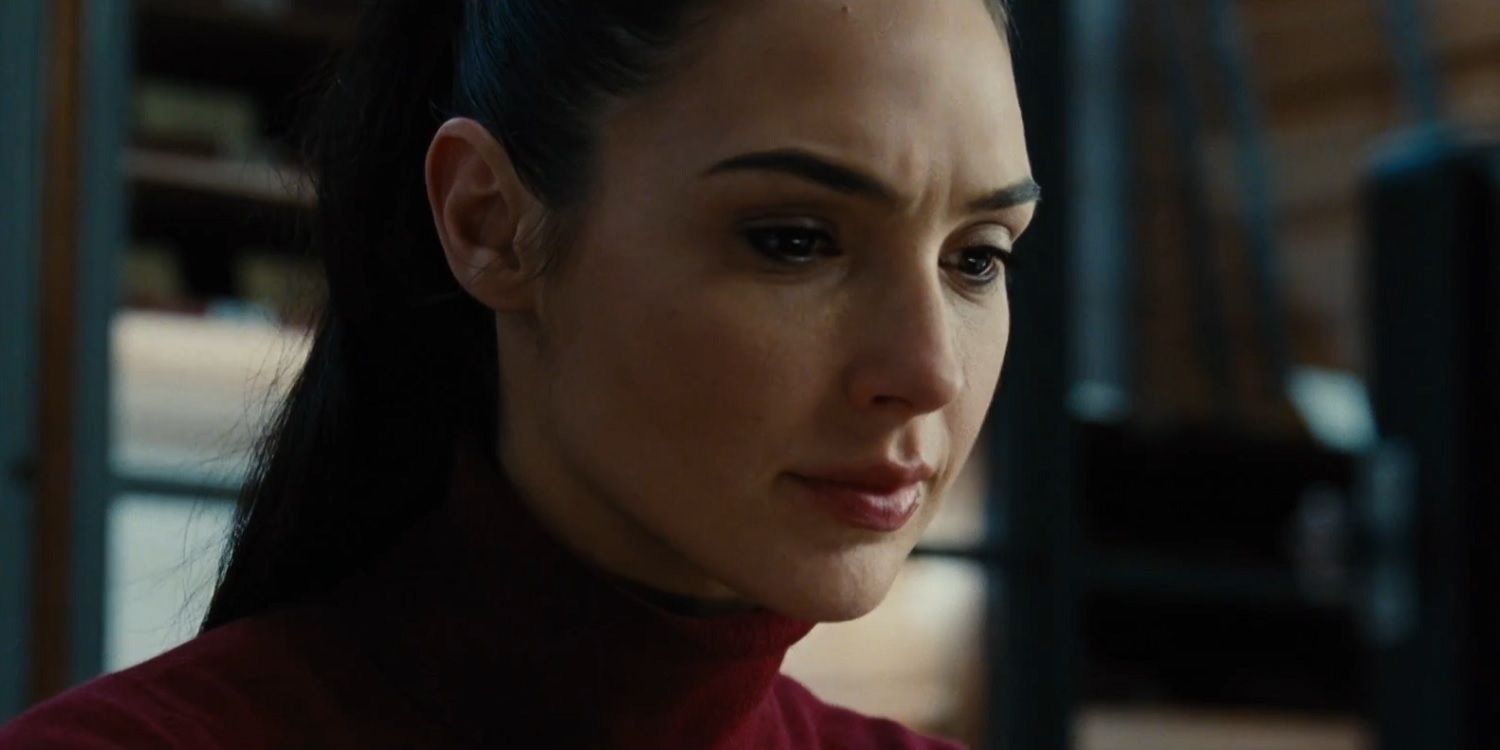NOTE: This article contains potential SPOILERS for Wonder Woman
-
It took some time to get here, but at long last, the critically divisive Batman V Superman is in our rearview mirror, and all eyes are falling on the next expansion of the DCEU. But even as Wonder Woman approaches with the promise of revealing how Diana first entered the world of man, the attention is shifting towards her Justice League incarnation. Zack Snyder is right to state that the next team-up will feature an "evolved" heroine, given the fallout and conclusion of Dawn of Justice, with Diana finally returning to the pantheon of Earth's superheroes. But those words also got us thinking.
Since that "evolution" began in Batman V Superman, at the hands of the exact same director, who planted plenty of references to her WWI-era past, it seems likely that the story was deeper than most noticed. After all, half the audience was apparently turned off by Snyder's aesthetic, the story, the version of the heroes, or countless other criticisms. The half excited just to see Wonder Woman, on the other hand, were likely containing their excitement until she appeared in full, armored spectacle. Just how much of her story did we miss as a result?
We've taken it upon ourself to put Diana's arc under the microscope, dissecting the choices made by Snyder and Gadot, the smaller details and references that may have slipped by, and the threads both literal and figurative that may be tied up by her solo origin story.
There's more here than most ever realized, and we hope our breakdown and analysis can give fans a new lens through which to view the DCEU's introduction to Diana, Princess of the Amazons.
The Unseen Introduction
At the time the film debuted, there's a good chance that plenty of casual moviegoers were focused more on the presence of a superheroine like Wonder Woman on the big screen to pay close attention to her characterization or dialogue (or, by contrast, too checked out of the film to care). But the introduction did as much to illustrate Diana's knowledge of the world as it did her feelings about it. We'll run down the details that have stuck out in our reading, especially as it pertains to what we already know about the circumstances of her upcoming origin story.
Her first appearance at Lex Luthor's invite-only soiree is a memorable one, but it's far from the entrance most superhero fans would expect. Superman's debut in Man of Steel reveled in spectacle, and even Batman was given a chilling entrance in Dawn of Justice, stuck to the roof of an abandoned building and fleeing with the speed and skill of a monster, not a man. While Diana is head-turning-ly beautiful, her entrance is almost unworthy of remark. Her first actual appearance is, fittingly, hidden among the crowd over Clark Kent's shoulder. But Diana takes center stage when she spots Bruce Wayne among the crowd - and is visibly rattled when he returns the look. She wanted to make note of his arrival, but did not want to be caught doing it.
The casual glance she throws Bruce's way as he makes his way out of the crowd can be missed, since it comes a second after her annoyed eyeroll at Lex Luthor's account of Greek history (including a wrathful, malevolent Zeus hurling thunderbolts). It's a subtle nod to the fans who know Diana is a bit better versed in the deities of the classical world than the Metropolis billionaire. It doesn't change the fact that she only has eyes for Bruce, and is never seen speaking or interacting with anyone. It's not what you would expect from a woman whose 'official' work clothes are red, blue, and gold, but we'll get back to that point later.
Keeping her interactions to a bare minimum doesn't just give her an air of mystery, but keeps her at arm's length to the audience, ensuring she's as inscrutable to us as she is to her co-stars. And it pays off immediately: where Bruce gathers covert intelligence with charm, and Clark gathers his as a reporter, the two are forced into a deadlock, allowing Diana to make her move to Bruce's purloined data drive without any interference. The pair do share a knowing glance, but what follows is perhaps just as meaningful a glimpse into the duo's skillset and training.
The film makes a point of showing Diana flowing effortlessly around the party guests and staff, leaving Bruce to look downright clumsy by comparison, dodging guests and massive cakes that hold him up long enough to catch a glimpse of Diana as she makes her speedy escape. Just to drive home the point: Batman, a detective devoting decades of his life to honing his senses, his body, his movements, and intellect... is made to look a clumsy fool by a woman he knows absolutely nothing about. To be fair, the only real conclusion would be that she has had a century of training to do the same. Impossible to consider, but the truth of the match-up.
The Museum Conversation
Some fans may have noticed the decision to introduce a version of Wonder Woman who was sly, deceitful, and concealed went specifically against expectations, and with good reason. Taken at face value, this version of Diana is every bit as antithetical to the core of her character as the initial version of Bruce Wayne is to his own. Alfred is present to confirm to the audience that Bruce has become this "cruel" reflection since Man of Steel, but there's no such insight for Diana... yet.
Her second appearance offers a bit more clarity, taking in yet another upscale gathering in a museum of antiquities. The scene plays out as follows: a man whom we learn to be the curator of the museum snatches up a glass of champagne and passes it to Diana, interrupting her conversation. Diana apologizes to the guests she was speaking to (not similarly beautiful socialites, but an older, white-haired couple who've seen the better part of the past century... interesting) and humors her new chaperone. Diana listens blankly as he brags about the decades it took to achieve his most prized artifact, how he knew better than historians, and how much of a "triumph" it is to finally have the artifact in his possession. He fails to notice Diana ditching the champagne, or that she's already aware the item is a fake.
Diana's relevance to such an artifact, like her reason for attending the event, is a mystery (for now). Yet she remains silent until she is "ambushed" by Bruce Wayne (bonus points for those who spotted him lurking, potentially sending the curator to "fetch" Diana unknowingly. Bonus bonus points for spotting his reflection over top of the sword). The moment clearly goes to Bruce's head, believing himself to have the upper hand, pressing the introduction even as Diana attempts to leave, and doesn't care for the hand he places around her arm.
Her playful tone makes sense as she states that he, like the curator - and other men of power she's presumably encountered in her past - have "no natural inclination to share." And with that, Bruce's assumed advantage evaporates: he was wrong to assume her actions were sinister since she sought something that was stolen from her to begin with, and best yet, the evidence is already in the glove compartment of his car.
Taking a step back though, let's look closer at the decision to pull Diana aside to be shown an admittedly fascinating relic (assuming it were genuine). Most audience members will grasp the reference to Alexander the Great, the Macedonian ruler who conquered the Persian Empire before his death in 323 BCE. The reference to his sword, specifically the one "that cut the Gordian Knot" may require a little explaining - especially given the connections it may hold to Diana's history, and that of her people.
To make a long story short, the capitol of Phrygia (modern day Turkey) in Gordium followed a prophecy that placed the future of its people in the hands of the person who could untie the knot of an ox cart sitting in the ruler's palace. It remained for centuries until Alexander arrived, and set about solving it. While the spirit of the legend may have expected a ruler smart enough to untie the knot, Alexander whipped out his sword, and sliced it in two. Some, like the curator, might see the act as a legendary "triumph" of thinking outside the box. Others would view it as the solution of a brute. Judging by Diana's tone and utterance of a simple "yes," we'd bet she's in the the latter group.
So, what does that have to do with Diana? In other words, why this artifact, mentioned here? Well, no matter how accurate the legend of Alexander and the Gordian Knot may be, historical accounts place it in the year 333 BCE as part of his larger conquest of Persian cities and territories. And just three years later, Alexander has another legendary encounter far more relevant to Wonder Woman. Around 330 BCE, a wide variety of tribes and armies from throughout the region gathered to speak with their new ruler, including a woman named Thalestris, Queen of the Amazons, accompanied by three hundred of her women warriors. And she came with one request: to bear Alexander a child.
The story has proven a curious one for historians, since the tale of an Amazon Queen arriving in search of sex, staying with Alexander for two weeks until confident of conception, and then disappearing sounds like an embellished legend. But key aspects of the story actually do adhere to historical records, no matter how fictional the rest of the story may be. And since Alexander won no son from the affair, one wonders what happened to the child (had it been a daughter, she would have been kept by Thalestris). And just like that, the origin of Diana and DC's Amazons gets a whole lot more interesting.
From what we know about the ancient prologue of Justice League, Queen Hippolyta, Diana's mother ruled the Amazons as an immortal even then. So if this story is lifted to the DCEU, it would have to be her, perhaps under a false name, who sought out a coupling for the daughter she might bear. So, is Diana the 2,300 year-old daughter of Alexander the Great, or will the comic version hold, and proclaim her the daughter of Zeus?
Either way, it establishes another link between actual world history and that of Wonder Woman... while providing one more example of a famous "hero" who proved just as greedy as a little boy. Not to mention the one who may actually be the villain of her solo movie.
The Photograph
It's downright impossible to forget the moment when Diana's history was revealed in visual form, when Bruce Wayne unlocked the photo of her alongside WWI allies in Belgium, 1918. If the electric cello sting didn't guarantee its place in every audience member's memory, then the fact that it was repeated when Diana accessed the photo certainly did. But there's a good chance that casual audiences were zeroed in on Wonder Woman's clothing, since it is the first look at her Amazonian armor on film. Meanwhile, more dedicated fans salivated at the early glimpse of her solo film, cast, and what looks to be a scene from that very film (at the time, no trailer had yet to drop).
A thrilling moment and a unique one for shared universes - but one that likely prevented audiences from examining the photo itself within the context of the film, as a device serving a non-marketing goal. Had we not known a Wonder Woman movie was coming, and had these actors been unknowns, for instance, the photo would play completely different. Sure, it confirms her age, or rather her immortality, as well as her presence in World War I. But that's not what's happening when she gazes at the photo in the privacy of her hotel room.
If her character were an everyday human a photo like this would most directly be a glimpse of her younger days, and the person she had been before life and time took its toll. In other words, involuntary changes that carry a note of regret. But for Diana that can't be the case. No, we're looking at the woman that she used to be-- factoring in her immortality, we're looking at the woman she once chose to be, and is currently choosing not to be. And not to put too fine a point on it, but this photo is a glimpse of Diana as everything that she has not been to this point in the film.
Examining the details of Diana's reaction - not the plot implications of Bruce Wayne revealing he's aware of her immortality and war record - shows what may be the most significant story beat in her character's arc. The woman in the photograph appears like a true Amazon: hair flowing loose, gaze determined, not cunning or deceitful, armor and shield visible as she looms physically larger than the men around her. The Diana in the photograph embodies the WWI-era Wonder Woman fans expect: the classical hero dropped into the modern world, part queen, part warrior... and Diana is left staring in disbelief a who she used to be.
It's no coincidence that Bruce's next messages drive even deeper into Diana's stunned self-image, stating that the photo doesn't just belong to her, but that "...it IS you." In the fiction of the story, it's plausible that Diana never actually saw this photograph at all-- perhaps even forgot it existed until Lex Luthor discovered it. And after a century of believing her younger self to have been naively optimistic, instead surviving by being unnoticed, unimpressive, is faced with the woman she actually was. Strong, visible, and perhaps most importantly, surrounded by friends.
Bruce's next message seems to (unknowingly) pose Diana with a choice she's been avoiding: "Who are you?" What follows is a montage of metahuman findings that send Diana running, clearly not able to deal with the stimulae. But from the audience's point of view, the road diverging before her should be clear: continue to exist in secret or, having been shown the powerful woman with powerful friends she used to be, accept Bruce's position that it "IS her." And if she can tackle the former, he's got a list of powerful friends just waiting to be found.
"I've Killed Things From Other Worlds Before"
It may be the most badass line uttered by the female fighter in the movie's running time, thrown away as a simple point of fact, and not the boast it could be from the lips of a more image-focused warrior. When Doomsday's unique ability to feed off of energy attacks is explained away by the fact that he's from another world, Diana reveals that she's met other inter-planetary travelers... and killed them. And as little as we doubt her claim, it's worth considering that actual world-building being achieved by that single line of dialogue. Especially considering our theories about the adventure she embarked upon before turning away from the world for a century.
Using imagination offers the simple explanation that threats arrived on Earth long before people were ever aware of them - threats dispatched by the ancient Amazons, or perhaps even the slightly more modern ones (who would... be the same ones, we suppose). Now the beasts facing Amazons are typically of the mythical or legendary, as opposed to the extraterrestrial, so it's not a comment that's as easy to brush aside as most might think. And it offers us two explanations, if taken on the surface level: Either Diana has battled the kind of alien footsoldiers that once fell to an alliance of Humans, Amazons, and Atlanteans, or the villain she's set to defeat in her solo movie is not of this world.
The Parademons of Apokolips technically appear in Batman V Superman and are sure to pop back up in Justice League (perhaps even in the prologue, too), so having a member of the team used to battling Darkseid's underlings would be useful. But the expertise or insights into the Apokoliptian shock troopers was expected to come from Cyborg, since he owes his life (and ability to interface with Apokoliptian tech) to a Mother Box. It's still possible, if strange, that scouting parties would come to Earth to face the Amazons directly over the millennia, but it's not the most intriguing reading.
Long before a Wonder Woman movie was being cast or filmed, it was assumed that Diana would be battling Ares, the God of War, in one way or another. Even though the WWI setting means a chemical weapons group under the presumed villain (played by Danny Huston) is the real threat, the trailer seemed to reveal a more supernatural nature. In short: that malevolent weapons designer is actually Ares, preparing to descend the world into the largest armed conflict ever known. We're presuming Diana will have no choice but to defeat him in combat, and Ares doesn't seem like the kind of deity to surrender and walk away peacefully.
No, Diana may have to kill him in her solo film - which raises the question: are the Greek Gods of the DCEU not divine figures, but inhabitants of another world? It may sound like a step towards an "ancient astronaut theory," but it's not that much of a leap from the DC Comics mythology. In the fiction, the "New Gods" survived the death of the "Old Gods" when their original "world" was destroyed. The damage resulted in a "Godwave" that spread throughout the DC cosmos, imbuing beings with godlike abilities (including the Greek Pantheon) before it rebounded back from the edges of space, creating the potential for superhumans, the Speed Force, and so on.
It's a clever explanation to tie all mythical deities and gods of human history to the superheroes of Earth and the likes of Darkseid's people, and as good a basis for the DCEU as any. But if Ares (and Zeus, and Hera, etc.) are beings from another world gifted with godlike powers with which to meddle with humans and Amazons, is Wonder Woman's line in Dawn of Justice a direct reference to her yet-to-be-released solo film? We might be tempted to think it's intentionally ambiguous, but when Zack Snyder included a message from the future Flash, and a vision of Darkseid's destruction of Earth, we're guessing it's a bit more specific.
So, good news: Diana may succeed in killing Ares, and Wonder Woman may explain the origin of the Amazons and Greek gods. The bad news: That war she left her home behind in an effort to stop? Well... it still happened.
"A Century of Horrors"
You don't need to be a history buff to know that World War I - the conflict she set out to stop, and prevent Ares from turning men against eachother with a death toll in the millions - wound up being the most horrific war the modern world had known. Once the machine got rolling, mechanized warfare, chemical weapons, machine guns and trenches turned much of Europe and North Africa into a meat grinder of human life and suffering. It eventually ended, but a "war to end war" it wasn't, as one conflict and genocide led into the next right up to the present day.
Diana clearly saw enough to know what was coming, and pass a judgement on the world that could allow, let alone encourage it. In the words she offers to Bruce following Clark Kent's funeral, she "walked away from mankind... from a century of horrors. Men made a world where standing together was impossible." The line obviously speaks to her own unwillingness to take the spotlight, and face the same venom Superman did. But the idea of men standing together also speaks to the fact that her WWI squad was comprised of American, Moroccan, Native American and Scottish ancestry. That's a group as culturally diverse and, quite possibly as doomed as the Justice League Bruce Wayne hopes to assemble.
We don't yet know how Wonder Woman's experience during the war ended, nor the fates of her allies (her love interest Steve Trevor in particular). Whatever happened was bad enough to turn her away from the world, and decide that living in secret, without a people, or a purpose, was preferable. In the Wonder Woman movie, audiences can now expect to see that story told, that mystery exposed. And where superhero stories tend to have happy endings, Patty Jenkins and DC are free to make the defeat and outbreak of war as tragic as it should be.
Because the deeper the tragedy, the more heroic Diana's return to battle, and newfound-- sorry, re-found willingness to believe in the best of humanity audiences got to witness in Dawn of Justice.
-
It may be an unconventional approach, but in the end, could prove just as effective in tracking the narrative journey of Diana in the DCEU, if not more so. She may take third billing opposite DC's heavyweight heroes, but in hindsight, we may look back at Dawn of Justice as the story that laid the foundations for Wonder Woman's rise to the top, before forging the Justice League alongside Batman. Not to mention a global war and astronomical death toll she may be able to stop - this time.

